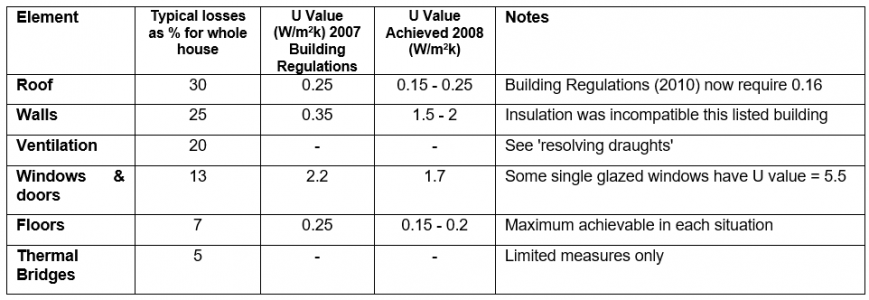Youlditch Farm House,
Peter Tavy

About
Youlditch was a farm until 1970, when it was modified for domestic use. When Peter and Angie Smith bought it in October 2003, they wanted to renovate it to 21st Century standards of comfort and convenience, while retaining its heritage character. Although several owners since 1970 had made significant changes (electrical power, pumped water, telephone, and conversion of the shippon into living accommodation), the buildings remained very damp, draughty and dark.
The most severe problem was damp which caused mould to grow in all ground floor and some first floor rooms. Moreover, exposed 1,000ft up on the west escarpment of Dartmoor, draughts entered the building both through the roof eaves and around the external doors and some windows. This made heating the shippon end of the building virtually impossible.
Dealing thoroughly with dampness and draughts was important to achieve energy efficiency, and a comfortable and healthy indoor environment. Moreover, it allowed an efficient (oil) boiler, under-floor heating, heating controls, and solar water panels to be installed.
Peter and Angie also built a new 84 m2 studio to replace a run-down workshop building: this studio has a heating requirement less than 5kW, with an air source heat pump also providing domestic hot water.

Energy reduction and conservation:
To improve energy efficiency, the problems with damp, poor insulation and draughts had to be resolved first. Energy reduction was also obtained by some behaviour changes, such as switching it off, dressing up for the season, and heating controls set at about 17 / 18 oC, at ground level and generally not heating upstairs rooms.
Insulation: High-level insulation was obtained by double-glazing both the house and the studio, and insulating lofts, roofs and the walls of the studio. The house inherently has high thermal mass, due to its thick walls and double glazed southwest windows. The table below summarises the impacts of insulation.

Note: The U-Value is the rate of heat loss through a material, expressed as Watts per square meter per degree centigrade. Lower U-values mean less heat is lost. Typical U-values for single glazed windows are 5.6, compared with 2.8 for double-glazing.
Energy generation:
Air Source Heat Pump – Space heating
A ‘Worcester Bosch Greensource’ 6kW air to water heat pump was installed. Because the water beneath the floors need only be heated to 30°C, compared to 65°C for conventional radiators, this is an efficient use of a heat exchanger. The heat is evenly distributed throughout the room and warms the internal fabric, including the thick walls with high thermal inertia. The result is a stable, comfortable environment. Thermostats control the temperature in each room (generally set between 17°C and 20°C). The air source heat pump also provides the (low volume of) domestic hot water required in the studio. The new boiler (18 to 25 kW Worcester Bosh Greenstar Camray Utility) is a modern oil-condensing boiler with an efficiency of about 93%, thereby reducing fuel use per kW by 20 to 30%.
Solar Thermal – Hot Water
‘Grant Sahara’ in-roof solar panel system for domestic hot water heating. There are two panels with an effective capacity of 3.4kW. This is fed to a 250-litre domestic hot water cylinder. The oil boiler will heat the water only when the solar panels have not sufficiently raised the cylinder temperature. Heating controls allow the boiler hot water function to be turned off to prevent unnecessary heating (i.e. before the sun is up) or set to cut-in for limited period to suit times when hot water is required. The solar heating probably satisfies about 60 to 70% of annual hot water demand.
Costs and benefits:
All of the above measures taken together have resolved the damp and draughty conditions, created a comfortable internal environment and achieved substantial energy use savings.
- Heat load saving about 50%
- New boiler and heating system efficiency saving of 20- 30%
- The energy use for heating is therefore reduced about 75%
Actual fuel use is about 50% less because some rooms are now heated for the first time, and the Aga use, which has not changed. The combination of measures reduced the maximum heating load (-50C outside/200C inside) from more than 30kW to about 18kW.
Lessons learnt:
RESOLVING DAMP:
- Stripping of the old plaster and repointing the walls with lime mortar, then re-plastering with lime plaster.
- Excavation about 600mm below the ground floor levels and laying field drains (perforated plastic pipes) in gravel sloping with the hill.
- Sealing the inside face of the walls in affected areas using two different types of tanking.
RESOLVING DRAUGHTS:
- Roof: Use of multi-layered fabric insulation that effectively sealed the roof against wind.
- Porches and doors: Replaced by the new screen wall porches with effective door seals.
- Chimneys: Lined and close fitted to the new wood burning stoves with proper door seals.
Additional information:
”Transition Tavistock , Food and Energy: Our growing book of community stories” booklet.
Contact details:
hello@tamarenergycommunity.com
Like to know more?

